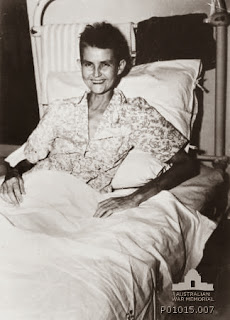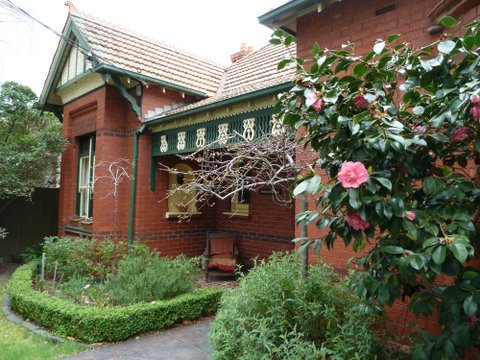
With the topic for Sepia Saturday 195 being International Peace Day, it seems appropriate that I should contribute a brief tribute in honour of a personal hero of mine, namely my late aunt, Patricia Morrison, known to her family as Pat. Christened Joan Patricia Morrison, she was born in Dunedin New Zealand on 29 October 1921, but soon afterwards her father finished studying law in Otago and the family returned to live in her mother Mona's home town of Christchurch. The eldest of a family of six, Patricia was a very bright student, and her interest in history, peace and human rights developed from primary school onwards. In 1932 aged just eleven, Patricia won First Prize Senior Division for her entry in a Peace Essay competition organized by the New Zealand No More War Movement. The newspaper photograph below shows young Patricia holding one end of the peace banner that she was awarded, and she also received a book as part of her prize. Sadly I haven't discovered a copy of her prize winning essay.



Patricia attended Somerfield Primary School, where she was Dux in 1933, for which accomplishment she received her first medal, shown above. She continued to excel at Christchurch Girls' High, and then obtained an MA degree with First Class Honours in History at Canterbury University. In connection with her master's thesis, she wrote a book on Christchurch entitled The Evolution of A City, published in 1949, which included a discussion of the considerable drainage problems that were faced when building a city upon swampy plains and underground streams. This is an issue which has been recognised as being particularly relevant today, in light of the disastrous liquefaction that occurred when damaging earthquakes struck Christchurch in 2010/2011, and Patricia's book is still regarded as an authoritative historical work.
Patricia won a three year scholarship to Oxford where she obtained another MA, and was active in the Student Christian Movement at both Canterbury and Oxford. Her interest in pacifism and international work led her to accept a position in Geneva in 1948 with the international committee of the International Students Service, having responsibility for field workers and working to find jobs for students and others displaced as a result of World War 2.

 |
Patricia, back right, with her siblings, c. 1942: Derek, Jean (my mother), Peter, Ken, who was killed in WW2 and Graeme. Only Jean is still with us. She remembers Pat as a happy child and an avid reader, always helpful and caring to her parents and siblings.
|
|
While working in Geneva in 1950, Pat sent a package of Swiss lace as her wedding gift to sister Jean, and it was skillfully made into Jean's wedding gown by their Aunty Bess, who was a professional dressmaker. Pat was back home in Christchurch for the baptism of her first-born niece in 1953
|
|
Patricia returned to New Zealand in the early 1950s, but a few years later she began working for the YWCA, and returned to Geneva, where she was based at the World YWCA headquarters. She travelled widely, often visiting remote and often dangerous parts of the world on her own, where she would meet with fledgling YWCA groups and listen to the needs of the local women and their communities, doing whatever she could to help, encourage and inspire them. Patricia and her parents corresponded weekly while she was away, but she once said that she hoped her father John did not know what she was doing, or he would have told her to give it up and come home! Patricia never married, but her twelve nieces and nephews regularly received handmade gifts for Christmas and birthdays, sent by their Aunty Pat from these distant countries.
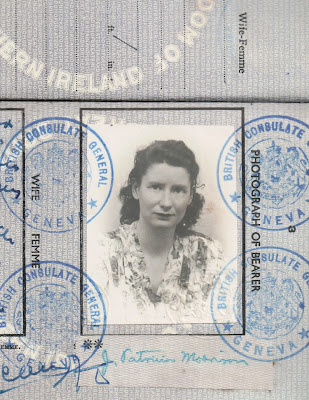 |
| One of Patricia's early passports,which were filled with stamps and visas from her extensive travels over the many years of her working life |
 |
| These nativity dolls sent to me by Aunty Pat in the 1960s were made by women she had visited in the World Y.W.C.A. Centre at the Aquabat Jaber Refugee Camp in Jericho,Jordan |
Leaving the World YWCA after ten years, Patricia then moved to London and worked there for another five years as General Secretary of the World Congress of Faiths, with a committee of leaders of six major world religions. When she finally retired and returned home to Christchurch, she continued to support, volunteer and be actively involved in many causes back in her home town of Christchurch. In 1997 she was awarded the Queen's Service Medal for her community work, and in the year of the 50th Anniversary of the Universal Declaration of Human Rights in 1998 she was chosen as the YWCA -Aotearoa New Zealand Human Rights Hero.
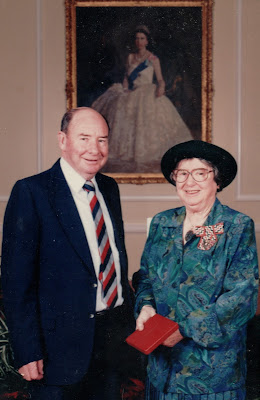 |
| Patricia Morrison with her brother Derek, wearing her QSM at the medal presentation in 1997 |
 |
| Patrica's Queen's Service Medal, now in my safekeeping. |
 |
| Acknowledgement of Old Girl Patricia Morrison's achievements in 1997, in a publication of Christchurch Girls High. |
Patricia's inner city council flat was badly damaged in the earthquake of February 2011 and combined with failing health, this meant she had no option but to move into a rest home. She struggled to cope with increasing frailty, but in response to my mother's suggestion that perhaps she should take things more easily, she simply replied: "Don't tell me what I should or shouldn't do, I know what I can do". For as long as possible she intrepidly continued to attend frequent meetings for the myriad of causes she supported, either walking to them in the inner city or on occasion taking a taxi to those that were further afield.One night she apparently got the address or date wrong, and was left in the dark at deserted hall, but thankfully a couple of girls who had been attending a AA meeting nearby kindly offered to see her home safely!
 |
My mother's scrapbook includes this cartoon and quote
by Bill Watterson, sent to her by Pat in 1998, who obviously
felt that it applied specifically to her
. |
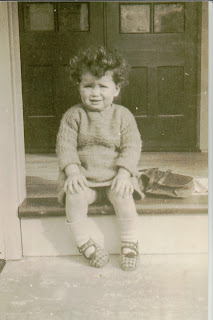 |
| Somehow that cartoon reminded me of this photo of little Patricia aged 4, already reading and eager to go to school and learn more |
Despite her dogged determination to go on doing what she loved, Patricia's health deteriorated rapidly and she passed away on 30 August 2011, just a couple of months short of her 90th birthday. At her funeral, which was widely attended by a large number of people including her many friends and acquaintances, several peace hymns were sung, including the one below, and a special candle was lit in her honour. Shirley Erena Murray, author of "Sing a Song for Peace and Justice", is an internationally acclaimed hymn text writer from Invercargill NZ, and was a personal friend to Patricia. A year earlier we had happily sung another of her songs, 'Come to a Wedding', at our daughter Laura's wedding, little knowing that through Auntie Pat we actually had a personal connection to the author. The other hymns chosen, "Deep in the Human Heart" and "Make me a Channel of Your Peace", were also very relevant to the selfless way Patricia had lived her life.
 |
|

The following extract from the obituary given at Patricia's funeral by Kate Dewes, herself a notable and awarded peace activist, tells more about Patricia's extraordinary achievements and interests, and shows the esteem in which she was held:
"Early in 2011 our Women's International League for Peace and Freedom group met together to catch up and plan the upcoming annual Hiroshima and Nagasaki Lantern ceremony. The smiling faces that day masked the depths of devastation we have all experienced since the [Christchurch] earthquakes started over a year ago. Some, including Patricia, lost their homes and we all knew people who had died....
She was a diminutive, self-effacing, humble woman who achieved amazing things as a leader promoting issues for women and families all over the world. She was a financial supporter of [the] Disarmament and Security Centre, the Peace Foundation, the Campaign Against Foreign Control in Aotearoa (CAFCA) and the Anti Bases Campaign (ABC), to name a few of the over 70 groups she supported.
In 2002 when Christchurch celebrated the 20th anniversary as the first Nuclear Weapons-Free City and became the first Peace City, Patricia was one of the inaugural recipients of the Mayor's Peace Awards. The citation recognised her leading role in the United Nations Association organising Model UN Assemblies for schools in Canterbury, the annual Lincoln Efford Memorial and John Grocott Peace Lectures... She was involved with a leading women's organisation which was pushing the boundaries everywhere on a wide range of issues. One example was when the US branch of the YWCA 30 years ago protested against the possession of guns. Their vociferous opposition resulted in them losing their funding, and male colleagues resigning from their advisory boards. But they stuck to their principles, which she admired. She admitted that she would often "take the flak" when she supported the younger women in YWCA who were trying to do things differently - like training social workers from all different ethnicities and faiths."
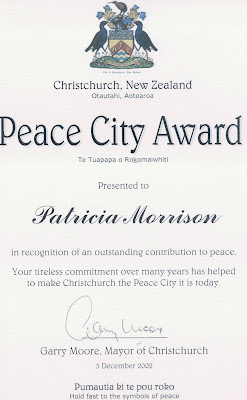
 |
| Citation on reverse of Peace Award |
 |
Joan Patrica Morrison, 1921-2011, on this International Peace Day, 21 September 2013,
we salute you!
|
To read more blogs on the subject of World Peace, check out this week's Sepia Saturday
Postscript:
Just as an aside, when looking through Pat's papers I came across the following anecdote related by my mother, which would have been quite apposite to last week's Sepia Saturday blog, #194: "While at Oxford Pat puzzled her tutors by always knitting as she studied, and said she could not study without knitting. During the war years, immediately preceding Oxford, Pat had knitted big sea boot stockings and balaclavas for men in the Merchant Navy. As a family we would sit around the warm fire knitting. As one brother remarked thoughtfully, 'there are only two people in this family not knitting, one can't and the other won't. The 'can't was the baby and the 'won't' was our Dad."
And finally... I thought I had no real sewing photographs whatsoever, but then just the other night I came across this one, among the treasure trove of papers and family photographs that had been stored for years in Auntie Pat's garage. I don't remember ever having seen it before, but I think that it must have been taken at the work place of Pat's Aunty Flo. Flora Euphemia Forbes worked in Christchurch City as a tailoress, and I believe she is the smiling lady in a white blouse, standing next to the suited young man wearing a jaunty tie at the far left of the group, middle row (second from end). I can't resist appending it here.



